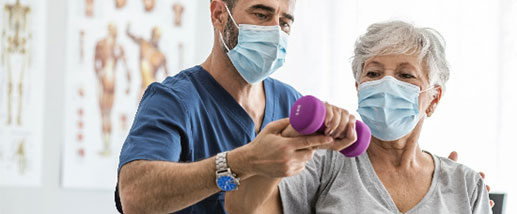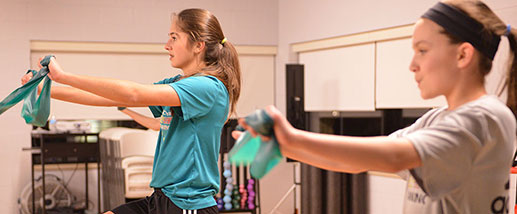Comprehensive Guide to Traumatic Brain Injury Recovery at Chelsea Hospital
March 19, 2025
By: Von Lozon
Categories: Ask a Doc, Neurosciences (Brain Spine, Nerves)
Tags: Brain Injury, Concussion, Neurology
Dr. Joshua Startup, the Associate Inpatient Medical Director of Inpatient Rehabilitation at Chelsea Hospital, shares his expertise on the treatment and recovery process for patients with traumatic brain injuries (TBIs). Dr. Startup discusses how patients are supported through their recovery journey with a team-based approach, the short-term and long-term goals of rehabilitation, and much more.
How do traumatic brain injuries (TBIs) most commonly occur? And what are some common symptoms?
Joshua Startup, MD: There are approximately 1.7 million TBI cases each year in the United States. Most of these injuries are mild in nature, like concussions, but hospitalizations have steadily increased over the years. The leading causes vary by age – falls are common among both older and younger individuals, while car accidents are a primary cause for those aged 16-25.
Symptoms vary depending on which part of the brain is affected. For example, an injury to one side of the brain can impact language, speech and motor control, while damage to the other side may affect the ability to perform everyday tasks and control impulses.
What criteria do patients need to meet to be admitted into Chelsea Hospital’s inpatient rehabilitation unit?
Joshua Startup, MD: Patients generally need to have been hospitalized and be able to tolerate and benefit from at least two of the three types of therapies — physical, occupational or speech. Physical therapy focuses on exercises and muscle movement to enhance mobility and reduce pain, occupational therapy helps patients perform everyday tasks, and speech therapy addresses communication difficulties and speech disorders.
What do you aim to accomplish with patients at the inpatient rehabilitation unit?
Joshua Startup, MD: Our goal is to create a personalized plan based on each patient’s individual needs, family support, and available resources. We initially focus on assessments and adjusting the plan as we see progress. We aim to prepare patients for a safe return home and get them back to a normal semblance of life. On average, patients stay at the rehabilitation unit for 10-14 days, and we are discharging anywhere between 42-67 patients per month, although the length of stay is individual to the patient. That is something we take great pride in, as these numbers show we are consistently helping patients recover and return home safely.
In what ways do evidence-based practices support the team in promoting patient recovery?
Joshua Startup, MD: Much of our evidence-based practices at the inpatient rehabilitation unit focuses on our multidisciplinary approach at Chelsea Hospital. Research in the acute phase of TBI often emphasizes quick intervention, but the post-acute phase that occurs in the rehab unit relies heavily on collaboration. Doctors (psychologists and physicians), nurses, therapists, pharmacists, the nutrition team, and so many more individuals work together to make sure each patient is receiving the highest quality care imaginable. Coordinating care with a team-based approach ensures that patients receive the comprehensive support they need.
How important a role does a patient’s family play in their recovery? And what advice do you have for caregivers?
Joshua Startup, MD: Family support is crucial in a patient’s recovery. Once discharged, patients rely heavily on their loved ones to help make the transition back home as efficiently as possible. Our team of neuropsychologists at Chelsea Hospital help educate family members about challenges they may face along the way post-discharge, as well as how to properly supervise the patient. Educating the patient’s loved ones is crucial, and it’s important for them to remain positive while helping their loved one recover.
Is there anything else you’d like to share?
Joshua Startup, MD: I’d just like to emphasize once again the importance of the entire team in a patient’s recovery. It’s not just the therapists or doctors, but the entire support staff, as well as the patient’s family. From acute care to rehabilitation and everyone in between, there are so many people that play a vital role in helping the patient regain their independence and safely return to living their lives.





